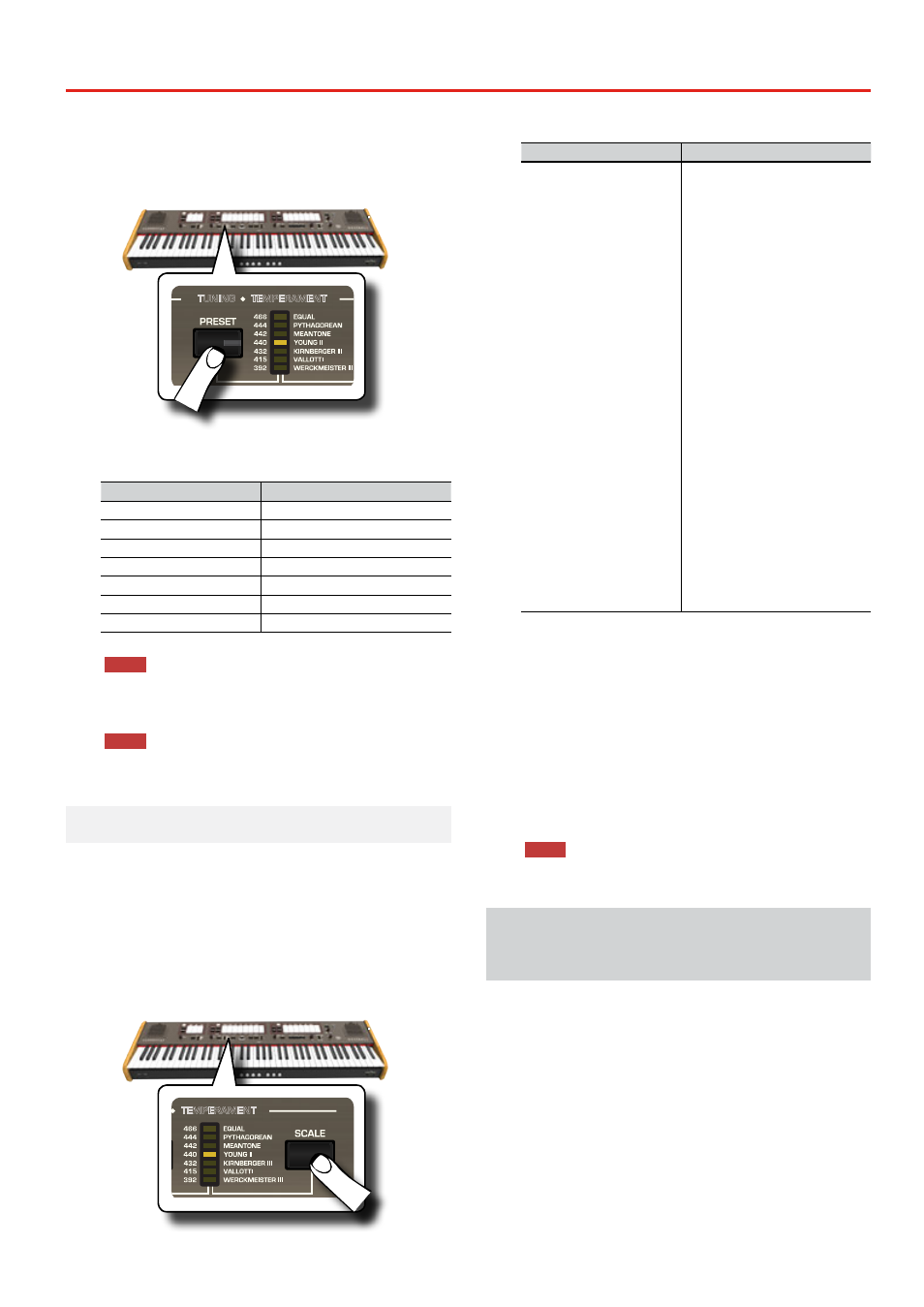Using different temperaments, How to adjust the volume of each organ register – Dexibell CLASSICO L3 76-Organ User Manual
Page 29

29
How to Adjust the Volume of each Organ Register
tuned differently than ensembles, even within the same region or town.
The CLASSICO L3 has some of the most used tuning preset.
1.
Repeatedly press the [PRESET] button until the indicator
of the desired pitch lights.
PIANO
HARPSICHORD
TUNING
TEMPERAMENT
TRANSPOSE
The new tuning is now available.
The available presets are:
Setting
Explanation
466 Hz
Venetian pitch
444 Hz
442 Hz
440 Hz
Modern pitch
432 Hz
Aura pitch
415 Hz
Baroque pitch
392 Hz
Versailles pitch
NOTE
If you need to match the pitch of another instrument, use the
[FINE] knob. You can adjust the pitch in a range of ±100 cents
centered on the current preset pitch.
NOTE
The tuning setting is not saved. Your changes are lost when you
switch off the CLASSICO L3.
Using Different Temperaments
The most tuning used for western music is called “equal temperament", where
the distance (interval) between any two semitones of an octave is the same. The
CLASSICO L3 uses this tuning at default.
However, in the past, and not so long ago, other tunings were used for classical
western music. These tunings are characterized by varying intervals between the
semitones of an octave. The CLASSICO L3 allows you to select from among seven
most used tuning methods.
1.
Repeatedly press the [SCALE] button until the indicator of
the desired tuning lights.
PIANO
HARPSICHORD
TUNING
TEMPERAMENT
TRANSPOSE
The temperament scale is recalled.
The available scales are:
Temperament scale
Explanation
Equal (default),
Pythagorean,
Mean-Tone,
Young II
Kimberger III,
Vallotti,
Werckmeister III
Equal
: This tuning is a correction of
Equal Flat. A benefit of stretching
octaves is the correction of dissonance
that equal temperament imparts to the
perfect fifth.
Pythagorean
: This system was
invented in ancient Greece. It resolves
the ambiguity of fourths and fifths.
Though thirds are somewhat imperfect,
melodies sound clearer.
Mean-Tone
: The Mean-Tone tempera-
ment provided an alternative to just
intonation, which derived the proper
tuning of all the intervals in the scale by
various additions and subtractions of
perfect natural fifths and thirds.
Young II
: YOUNG second temperament,
proposed to the Royal Society in 1800,
is very similar to Vallotti, except Young’s
tempered fifths run around the sharp
side of C instead of from F.
Kimberger III
: As a result of improve-
ments made to the Mean Tone and Just
temperaments, this tuning system is
relatively tolerant towards transposition
and can be used to play in all keys.
Vallotti
: This tuning is the default for
many of today's Baroque musicians.
Werckmeister III
: A combination
of the Mean Tone and Pythagorean
temperaments, this tuning allows for
playing in any key..
Selecting the Key Note (root note)
When using a temperament other than Equal temperament, use
this procedure to specify the key signature of the piece.
1.
Press and hold the [SCALE] button.
The scale indicator flashes to mark that we are in root note edit
mode.
2.
Press a keyboard key for the root note you want specify.
3.
The keyboard leaves the edit mode and the root note is
selected.
NOTE
The temperament and the scale tune settings are not saved.
Your changes are lost when you switch off the CLASSICO L3.
How to Adjust the Volume of each Organ
Register
You can adjust the volume for each register of the organ (MANUAL I, MANUAL II
and PEDAL division).
1.
Press and hold one of the tilt tab (MANUAL I, MANUAL
II and PEDAL division) of the register you want to adjust
until it's indicator flashes